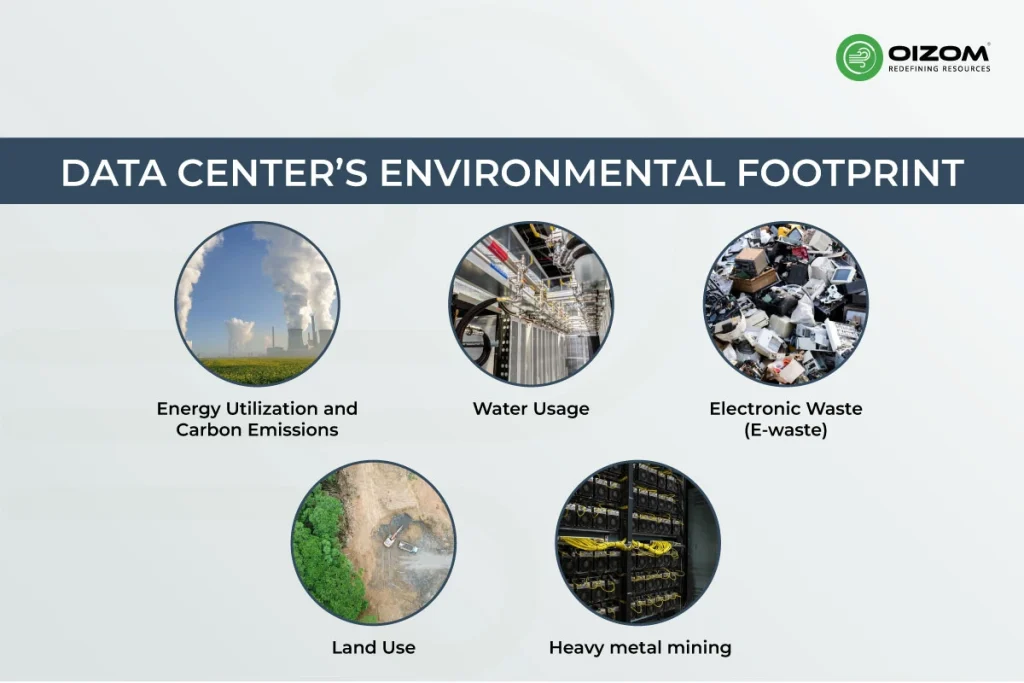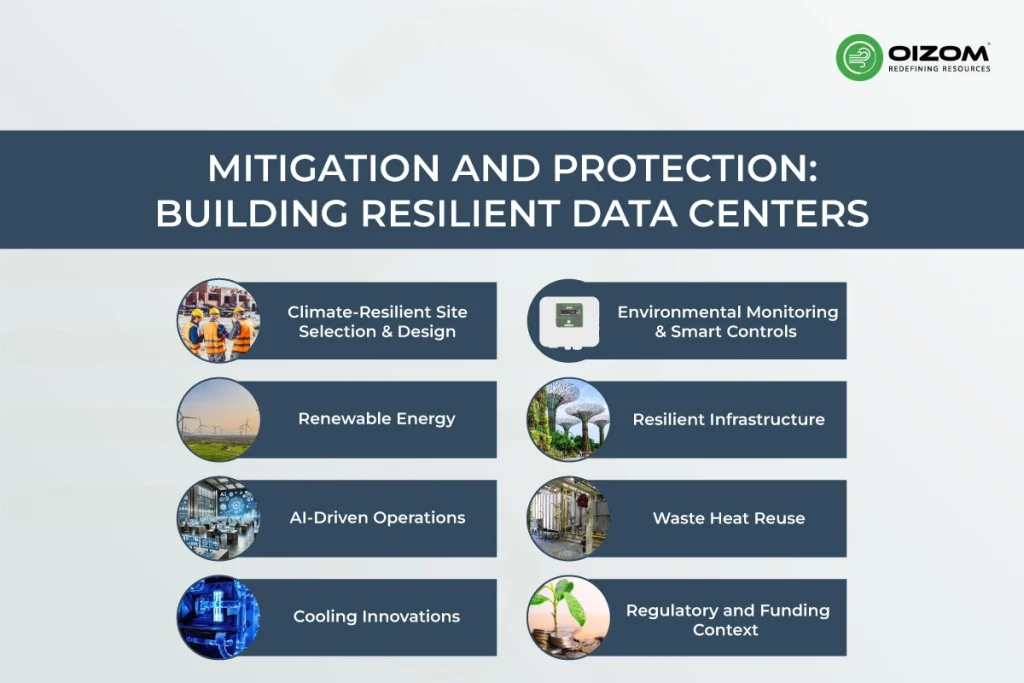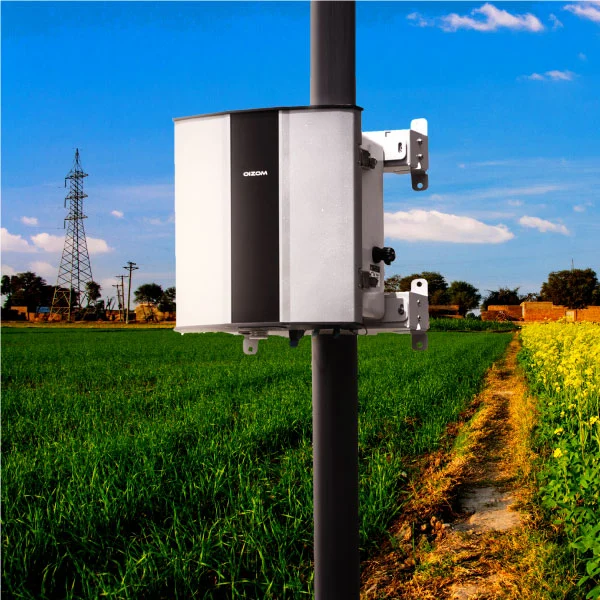Summary
Data centers are the backbone of today’s digital world, supporting everything from cloud storage to streaming to AI and online communication. Although they enable smooth digital experiences, their backend operations carry profound environmental implications. Right from consuming massive amounts of energy, relying heavily on water for cooling, generating electronic waste, and demanding large land areas, all of which add to their environmental footprint.
However, at the same time, data centers are also simultaneously affected by environmental factors like rising temperatures, extreme weather events, air pollution, and water shortage, which can disturb operations, raise maintenance needs, and challenge reliability. To address these issues, operators adopt strategies like high-efficiency filtration, air quality monitoring, corrosion prevention, flexible cooling solutions, renewable energy integration, and resilient site design. By managing both their environmental impact and vulnerability, modern data centers strive to operate efficiently and sustainably, supporting the growing demands of a tech-dependent society.
AI and Sustainability: Can Data Centers Balance Both?
Data centers are both the enablers and the demands of our modern age. From one angle, they digitally empower us by operating, powering AI, storing images, and supporting every digital interaction we take. These windowless facilities and their functions have become invisible yet crucial, gradually supporting a world that increasingly runs on data. However, all that computing power comes with a heavy environmental price. From energy consumption to massive e-waste generation, water use, and even land transformation, data centers leave a footprint far larger than most of us realize.
On the other hand, these same facilities are at the mercy of the environment itself. Rising temperatures, extreme weather events, air pollution, and water shortages can threaten their smooth operation, forcing operators to rethink cooling, energy, and resilience strategies. Understanding this delicate two-way relationship, how our digital demands impact the planet, and how environmental stressors affect critical infrastructure is essential for building a sustainable future.
In this blog, we explore that intersection, exploring not only the challenges but also the innovative practices and technological solutions that make modern data centers more efficient, resilient, and environmentally conscious, helping both people and the planet coexist in harmony.
Data Center’s Environmental Footprint
When we think about pollution or environmental burden, the first thing that comes to mind is smog coming out of extensive industrial facilities. However, data centers, the windowless, quiet buildings that keep our virtual world alive, have their environmental tale, and it’s larger than most imagine.

1. How Much Energy do Data Centers Use?
Data centers are energy-intensive facilities. Every email sent, video streamed, or AI model trained requires numerous servers running nonstop, along with cooling systems to prevent overheating. Globally, these facilities are estimated to consume 1-2% of the world’s electricity, and that number is steadily increasing as cloud computing, IoT, and AI workloads grow.
For example, in 2023, U.S. data centers consumed approximately 176 TWh of electricity, higher than the annual usage of some entire nations, such as the Philippines (it consumed about 110–118 TWh of electricity in 2023).
Data centers in Ireland consumed 18% of the country’s overall electricity consumption in 2022, leading energy regulators to suspend new build approvals.
A lot of this power is still derived from fossil fuels, so each gigabyte of data handled has a carbon price tag. Until renewable energy is the norm, the sector’s carbon footprint will be massive.
2. Why do Data Centers Consume so Much Water?
Maintaining servers at a cool temperature is essential for their performance and availability, and for some data centers, that requires a significant amount of water. High-capacity evaporative cooling facilities can use millions of gallons of water per day, burdening local water resources, especially in dry areas. In Mesa, Arizona’s “AI data center belt,” local concerns have grown over putting additional pressure on already limited water resources.
While others are resorting to air-cooled or liquid immersion systems to reduce water consumption, the secondary effect cannot be overlooked. Electricity generation for these facilities also consumes water, such that their water footprint is not limited to the facility itself.
3. What Role do Data Centers Play in the E-Waste Problem?
Technology advances quickly, and in data centers, the refresh cycles of hardware are even quicker. Servers, storage devices, and network equipment are upgraded long before the end of their usable life to maintain performance. This generates a constant supply of e-waste with metals, plastics, and toxic elements such as lead and mercury. Irresponsible recycling risks the leaching of these substances into the soil and water.
4. How do Data Centers Impact Land and Ecosystems?
Some high-capacity data centers can extend hundreds of thousands of square feet, altering the landscape and affecting local ecosystems. Though multiple sites are located in industrial parks, land acquisition for new properties can still challenge agriculture or natural environments.
5. What Hidden Environmental Issues Come with Data Centers?
Aside from the bigger issues like energy use, water consumption, and e-waste disposal, there are some lesser-known but essential issues:
- Noise pollution due to cooling systems and backup generators.
- Emissions from diesel generators under power outages or test cycles.
- Battery production effects, particularly heavy metal mining.
- Leakage of toxic coolant can be dangerous if not disposed of correctly.
Environmental Pressure on Data Centers
1. Extreme Weather Events & Heat Stress
The climate crisis has made data centers go from passive actors to exposed ones. During July 2022, the UK experienced a record-breaking heatwave. The temperature in London hit above 42 °C, straining NHS data centers and taking down hospital lifelines. Three months were needed to restore operations fully at a cost of approximately £1.4 million in tech recovery alone, excluding wider consequences. These weren’t isolated incidents; Google and Oracle data centers in London were shut down, taking services across continents offline.
Furthermore, an astonishing 45% of U.S. data centers reported that severe weather conditions posed a threat to their operation at some stage. Maplecroft also issued a warning that 75% of the world’s data-center hotspots will experience heightened cooling requirements between 2030 and 2080, with cooling demands increasing up to 83%. This puts added pressure not only on operations but also on insurance premiums, which can quadruple by 2050 if resiliency is not incorporated.
2. Air Pollution, Dust & Corrosive Gases
Dirty air is not just an aesthetic issue; it’s a threat to a malfunction. Pollutants such as PM₂.₅ and PM₁₀ can deposit on circuitry, causing performance degradation or mechanical failure. Turbulent air from cooling fans prevents particles from sticking to sensitive components.
Areas with bad air quality, risk of wildfires, or industrial emissions require additional attention. Even the best HVAC filters won’t prevent particles from collecting. This serves to highlight why air quality control is as essential as temperature control for high-performance buildings.
3. Resource Scarcity: Water & Energy Pressures
Water shortage is not solely a matter of drought; it’s a coming danger to cooling systems. Cloud workloads and AI are driving investments into areas that are already water-stressed. In Brazil’s Caucaia region, for example, a hotbed of AI data centers, facilities use as much as 80% of the water they pull from the ground, frequently stirring up tensions in communities.
In the UK alone, data centers consume close to 10 billion liters of water every year, depleting the local supply during long-lasting droughts (particularly in southeast England). In Virginia, USA, politicians are demanding regulatory water-use reporting from data centers hosting Amazon, Google, and Microsoft, fueled by growing concerns over water usage linked to AI activity.
In addition, a study estimates AI will require 4.2 – 6.6 billion cubic meters of water by 2027, more than half of the UK’s yearly withdrawal in 2023. Simply training GPT-3 alone, for instance, might have evaporated 700,000 liters of water.
4. Energy Instability & Grid Stress
Increased workloads result in increased stress on power grids. In Texas, where growth in data centers is exploding, a new bill now authorizes the state to shut off power to sprawling facilities in grid emergencies, a symptom of increasing worry about energy reliability.
Air Quality Management in Data Centers
It is crucial to keep data center air quality at the ideal level to preserve the lifespan of hardware, maintain operational efficiency, and ensure continuous service. Only airborne particle levels or corrosive gas levels are enough to cause component failure, downtime, and higher maintenance costs. Good air quality management demands explicit standards, effective sensor location, precise filtration, and corrosion protection practices.
Industry standards like ASHRAE TC 9.9, ISO 14644-1, and ISA-71.04 establish limits for particulates, humidity, temperature, and gaseous impurities to reduce contamination and corrosion risks. Continuous measurement of particulate levels, temperature, humidity, and gas content helps operators detect changes early. This enables them to respond early, thereby maximizing cooling equipment efficiency for energy conservation.
Accurate and precise outcomes are determined by planned sensor positioning close to HVAC units, within server racks, return air ducts, and busy locations. Air quality can be improved by high-efficiency filtration, positive pressurization, routine HVAC maintenance, and humidity control to avoid static discharge and corrosion. AI data centers, with higher server density, workloads, and increased heat/airflow requirements, have higher exposure risks from fine particles and corrosive gases.
Gaseous pollutants such as SO₂, H₂S, and chlorine cause corrosion of copper and silver in printed wiring boards, and hence gas detection systems and corrosion test coupons are essential. Protection measures involve gas-phase filtration, sealing of cable/duct penetrations, and corrosion monitoring through reactivity coupons or real-time sensors. Proper differential pressure between server rooms and surrounding areas eliminates the risk of unfiltered air entry, and corrosion control methods like air scrubbing, corrosion inhibitors, and periodic inspections provide additional protection for equipment.
Overall, optimizing indoor air quality (IAQ) within data centers saves money on maintenance, avoids downtime, and prolongs the life of infrastructure
Mitigation and Protection: Building Resilient Data Centers
For safeguarding our digital ecosystems from the unpredictability of nature,
The stakes are high. From increasing climate risks to fluctuating energy markets, the future depends on resilience. Here’s how the data center industry is keeping up:

1. Climate-Resilient Site Selection & Design
The choice of location is of utmost importance. Putting data centers outside flood areas, using raised buildings or flood-resistant materials, can eliminate disaster-related outages. Design also includes seismic bracing, drainage, and hoisting crucial equipment.
2. Renewable Energy & Energy Autonomy
Long-term power stability comes from adopting renewable energy. Hybrid setups of solar, wind, microgrids, and battery storage help data centers handle power outages and rising energy costs. By integrating a virtual power plant technology, the center not only becomes resilient but also grid-responsive.
3. AI-Driven Operations
AI and ML are redefining the way operations respond to environmental pressures. Proactive measures and real-time monitoring can drive cooling systems, power consumption, and maintenance schedules with accuracy, risk control, and cost reduction.
4. Cooling Innovations
Traditional air cooling systems often fail under rising peak temperatures. New age solutions such as liquid immersion cooling and direct-to-chip technologies are advancing, providing higher energy efficiency and improved heat management.
5. Environmental Monitoring & Smart Controls
Climate-resilient data centers rely on heavy sensor ecosystems and automation. Digital twins, remote sensors, and analytics help operators figure out heat, humidity, or power issues and fix them before system failure.
6. Resilient Infrastructure
Building resilience usually includes a distributed infrastructure. With geo-redundancy, when one center fails, another can jump in right away. Similarly, local backup facilities, including UPS, batteries, and generators, keep things running during outages.
7. Waste Heat Reuse & Passive Resilience
A more creative design will make your waste heat an asset. Facilities such as the NCAR-Wyoming facility take advantage of natural cold conditions to lower cooling requirements by around 89%, while recirculating heat to neighboring buildings, melting snow, or using hybrid applications. Passive methods (such as insulation, thermal buffering, and thoughtful orientation) also decrease energy dependence during disruptions.
8. Regulatory and Funding Context
Investing just about 3% of a data center’s valuation in preventive measures (like flood barriers or elevation) can lower climate risk significantly by over 70% globally. But many regions still lack policy incentives to make this common practice.
9. Future Trends
With growing climate risks, up to 80% of critical data center locations are at high risk by 2080, and customer demand, resiliency is essential. It’s a core requirement for sustainable, future-proof infrastructure.
Future Trends in Sustainable & Resilient Data Centers
Data centers are now increasingly moving away from being energy-intensive to becoming sustainable. The focus is towards energy-efficient facilities, with operators embracing cutting-edge cooling solutions like liquid cooling and free-air cooling to minimize reliance on energy-consuming HVAC systems. The incorporation of renewable energy sources, especially on-site wind and solar, is emerging as a hallmark of green data centers. Power use effectiveness (PUE) is now widely regarded as a critical metric, with companies aiming for near-optimal efficiency ratios.
Side by side, circular resource management, maximizing hardware life cycles, server component reuse, and e-waste recycling to minimize environmental impact, is gaining traction.
In the future, the focus will be on AI-powered operations that forecast energy and cooling requirements in real time, as well as microgrid integration to improve resilience and sustainability. With regulations becoming stricter and customer demands changing, sustainability will become an essential tool for staying globally competitive and relevant in the market of data infrastructure.
Conclusion
Data centers support our digital system; however, they carry a heavy environmental cost. They utilize energy and water intensively, generate e-waste, and require large land areas. Meanwhile, rising temperatures, extreme weather, and air pollution disrupt operations. Responding to these challenges requires strategies like efficient cooling, air quality monitoring, corrosion prevention, renewable energy use, and resilient site design. Only by understanding the dynamic relationship between data centers and the environment can we facilitate the need for sustainable, reliable infrastructure. In this way, we can maintain our digital ecosystem to operate efficiently while minimizing its impact on the planet.






